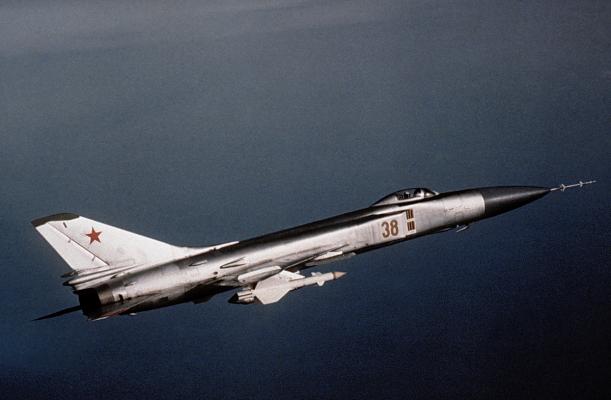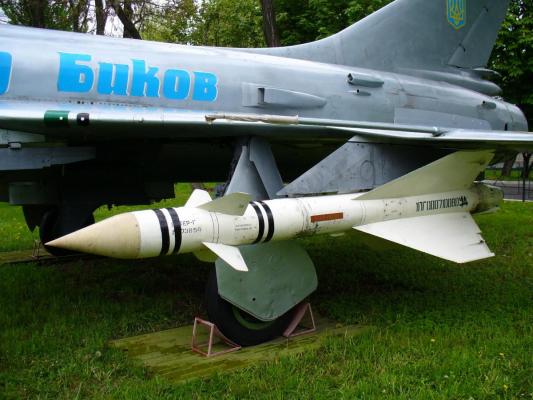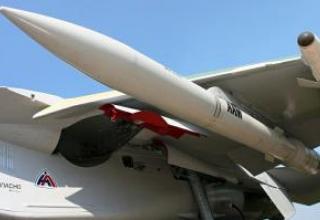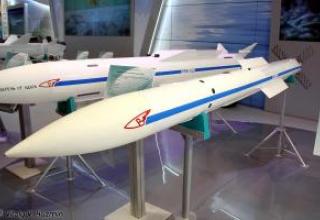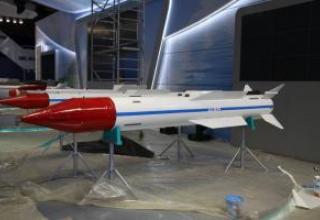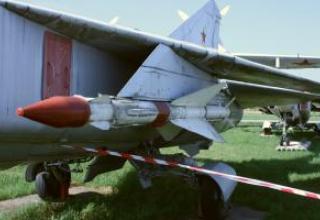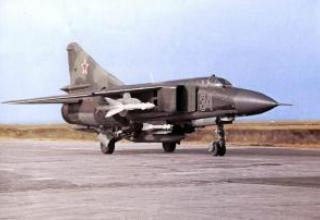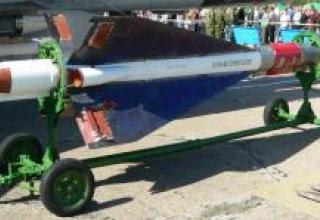The K-98 medium-range aviation missile was designed as a deep upgrade of the K-8M missile and was intended for an improved version of the Su-11, the T-58 interceptor specified by the February 1962 Decree of the USSR CM.
The main focus of the K-8M upgrade was to ensure that the missiles could be launched not only from the rear but also from the front hemisphere, increasing interference immunity and combat efficiency. The first studies of the corresponding modification of K-8M-2 designed for use with T-3 and Yak-28 were carried out in 1961. Subsequently, the original name was changed to K-98 ("item 56").
In 1963, was released 31 missiles, launched flights IL-28, Tu-16 and Yak-28, confirmed the possibility of "radium" missiles from the front hemisphere, the first two launches of missiles with thermal GSN on parachute target M-6 at altitudes of 10 and 15 km.
In 1964, during tests of the T-58-98 complex, the results were obtained, which made it possible to give recommendations for adoption into service. In particular, there were 10 launches of telemetry missiles on targets M-6 and PM-4108, 13 launches of combat missiles (including seven K-8M-1) from the rear hemisphere on targets IL-28 and Yak-25 and seven - on IL-28 from the front hemisphere, all target aircraft were shot down. K-98 tests on Yak-28P were no less successful.
The missiles were equipped with new PARG-14VV homing radar heads, more suitable for low altitude applications. In particular, 14 launches on the IL-28 at altitudes of 500...700 m were successfully passed. All targets were also shot down during missile launches from the front hemisphere at altitudes from 7000 to 17000 m. Military tests with rocket launches on targets La-17 and MiG-17 were also successfully passed. The state tests were completed in June 1964.
In accordance with Resolution No 365-131 of 30 April 1965, the Su-15-98 interceptor complex based on the Su-15 interceptor (T-58-2) came into service with the RP-15 ("Eagle-DM") radar fitted with R-98 (K-98) missiles. The missiles were suspended one under each wing console on PU-1-8 launchers. The usual version of the suspension included one missile R-98R with a semi-active homing radar head and one missile R-98T with a thermal homing head C1D-58. The missiles can be launched either by one or by volley.
For the first time in the USSR, R-98 missiles with semi-active radar allowed for use not only from the rear, but also from the front hemisphere of the target. In the latter case, at high altitudes, the launch range on targets at speeds up to 2000 km / h increased to 18 km with a target height of 5 to 18 km. When launching the maximum target range remained at the same level - 14 km, which should have been expected with the same engine type PRD-25. At launches in the rear hemisphere for rockets with both types of CNS the altitude of application was provided from 500m to 23000 m. The target altitude could reach 3 km above the interceptor.
However, despite the adoption for service, to ensure the successful use of R-98 missiles, the complex required a number of modifications and additional tests carried out in 1965. 1967.
The next stage of improvement of Sukhoi Design Bureau's interceptors was initially linked to the new Korshun-58 radar and K-58 missiles ("item 57") with the PARG-16VV radial GSN and PRD-143 engine. However, due to delays in the development of the Korshun-58 in 1968, a decision was taken to introduce on the Su-15 an improved version of the Smerch-AS radar named Typhoon. The missile was renamed K-98M, retaining the "unclassified" designation of "item 57".
The factory tests of the new version of the plane, named Su-15T, carried out since January 1969, revealed the need to improve the onboard radar. An Su-15TM aircraft with the Typhoon-M radar was already presented for state testing, which started in August 1970. In April 1973, the state trials were completed with a recommendation to adopt the aircraft for service.
On 21th January 1975, pursuant to Decree No. 72-26, a new modification of the interceptor was adopted for service and officially received the name of the Su-15TM, with the radar being the RP-26. The improved K-98M missiles received the index P-98M.
The K-98Ms were characterised by enhanced noise immunity of the GSN and an extended launch range. The minimum launch altitude of the R-98MT compared to the R-98T in the front hemisphere decreased from 5,000 to 2,000 m, and the maximum altitude increased from 18,000 to 21,000 m (in the rear hemisphere - from 23,000 to 24,000 m).
Missiles were used on the Su-11, Su-15TM, Su-15UM and Su-17M fighter-interceptors (P-98MT only).
R-98 missiles under difficult weather conditions and at night were shot down by South Korean "Boeing" missiles, which violated the air border of the USSR in 1978 and 1983. The first of these missiles hit the Kola Peninsula in the clouds and the damaged plane was able to make a forced landing (and in the fever of the attack, the Su-15 pilot, who saw the Boeing 707 only on the radar screen, fired the remaining missile at the "detached second target" - the broken wing console of the intruder). The second, a Boeing 747, fired both heat and radium missiles from a distance of 11 km at night, hitting the fuselage and one of the engines.
Composition:
The missile K-98 ("item 56") was made according to the aerodynamic scheme "duck" with ailerons on its wings (see projections).
The P-98 (P-98M) missile is technologically divided into 4 consecutive compartments. Mounting of the tail compartment is of flange type, the other interchannel joints are of telescopic type.
Rockets with thermal and "radius" CNS differ only in the first compartments. In the PARG-15 P-98R homing radar head, a compensation antenna facing the ground has been introduced to improve the signal-to- background ratio and increase the range at low altitudes. This required the stabilization of the missile on a roll in the scheme X regardless of the roll of the aircraft at the time of launch. The P-98T missile with thermal GSN in the first compartment has a compressed nitrogen balloon to cool the infrared receiver. Target acquisition by both types of CNS missiles was carried out on hanger under the carrier. Guidance method - proportional guidance.
Aerodynamic rudders are located at the front of the second compartment, with all-wheel steering consoles lying in one plane, kinematically connected to each other and operated by one air-operated steering machine. Then, in the second compartment are sequentially located autopilot, two-wave radio detonator and blast contact devices, shrapnel fighting unit with installed in front of the safety executive mechanism and, aft of the compartment, an ampoule battery of direct current. Closer to the sides of the ampoule battery are the roll channel steering vehicles.
The third compartment is a combustion chamber of single-mode RDTT PRD-25. The engine charge is made of RNDSI-5K (PAM-10K) ballistic fuel. The elongated RDTT nozzle passes through the center of the fourth, tail compartment, and on its periphery there are tore cylinders with compressed air for power steering machines.
On the Su-15, the rockets were suspended on PU-1-8, on the Su-15TM - on unified PU-2-8, which also allowed the use of ANR and bombs.
Characteristics:
| R-98 | R-98М | |
| Maximum speed of the target, km/h. in the anterior hemisphere in the posterior hemisphere |
2000 1800 |
2500 1800 |
| Altitude range of the target, km | 0,5...23 | 0,5...24 |
| Maximum launch range, km in the front hemisphere in the posterior hemisphere |
18 14 |
24 14 |
| Minimum launch range, km ZPS | 1,8 | 1,8 |
| Overload of intercepted target, units | 2,0 | 2,0 |
| Weight, kg | 292 | 301 |
| Weight BC, kg | 40 | 39 |
| Hull diameter, m | 0,275 | |
| Length, m | 4.17 | 4.22 |
| The plumage scale, m | 1,22 | |
| Energy efficiency, kgc/kg | 66 | |
| Targeting the head: RGS - TGS - |
φ cu = ± 60° φ cu = ± 30° |
|
Testing:
From September 1 to November 28, 1945, the Nb.W.42 trophy mortar was tested at the Red Army State Automobile and Space Administration. The tests were carried out on the basis of the order of the Deputy Chief of SAKP, Major-General of the Engineering and Artillery Service of Serebryakov under the program of the range - SAKP task №4410.
In the report No 0116 dated 19.1.46 the description of the device and operation of the Wgr.42 mine, L.J.gr.Z23nA fuse and the mortar were given. Data on the heap and range, as well as theoretical calculations of internal and external ballistics are given. In addition, the report contains the results of analysis of the hull materials and equipment. The test manager was Captain Lerner.
The purpose of the tests was to determine:
- basic characteristics of the mortar and the mine Wgr.42 /description of the device, operation and purpose/.
- Intraballistic characteristics Wgr.42 /powder gas pressure and charge burn time/.
- aerodynamic characteristics Wgr.42 (wind tunnel blowing).
- The impact and maximum mine speed and the nature of mine buildup in the active area.
- Maximum range at 10°, 20°, 30° and 45° elevation angles.
- The mine's blast and fragmentation effect on the target.
- the system's strength, stability and rate of fire.
When measuring five minutes on centering belts, the projectile caliber was 214 mm, so the report suggested "counting the caliber not 210 mm as usual, but 214 mm".
The conclusions of report No. 0116 were as follows:
- The 210 mm Wgr.42 rocket projectile with the M-13UK missile was characterized by simplicity, cheapness and availability of materials that were used for its production. It was noted that the Germans considered it possible for missile chambers to allow deformation at maximum pressure beyond the elastic limits, i.e. the chambers were calculated not on the elastic limit, but on the temporary resistance to rupture with a margin of strength of the order n=1.5.
- Manufacturing of dinitroglycol powders for rocket charges had advantage in comparison with manufacturing of nitroglycerine powders. As glycol was based on cheap raw material base (vegetable oils), and glycerin was mainly produced from animal fats.
During the study of the mine, it was disassembled into structural elements. See their photos: photo 1, photo 2, photo 3, photo 4, photo 5, photo 6, photo 7.
From August 8th till August 13th 1945 at the State Mine Stockpile of Ukraine there were conducted shooting to determine experimental data for drawing up tables of shooting. Shots were fired at an elevation angle of 10°, 20°, 30° and 45° (maximum possible elevation angle).
The mortar was simultaneously loaded with 5 shells. The mortar was fired in single shots. The charge was corrected after each shot, and the shoot down rate was insignificant. Due to lack of German mortar sight, side aiming was made with MP-41 sight.
As a result of tests it was received:
- The puchiness and range of the 210 mm Wgr.42 missile did not differ from the characteristics of the domestic M-13UK projectile. When the angle of Ө decreases (elevation angle) the heap drops sharply especially in range: gri Ө=10° the range of 2650m and the WDX = 1/17 was obtained; WDX = 1/58, at Ө=45° the range of 8000 m and the WDX = 1/88; WDX = 1/76.
- The effect of the Wgr.42 mine on the target was undoubtedly more powerful than that of the M-13UK, as the 210mm projectile carried 9.27 kg of explosives, while the M-13UK carried 4.55 kg. However, the Wgr.42 has a smaller fill factor /WB to passive weight ratio than the M-13UK. The M-13UK had a filling ratio of 13% and Wgr.42 had a filling ratio of 10%.
- The design of the Wgr.42 mine was characterized by the simplicity, affordability and accessibility of the materials used in its manufacture.
- Calculation of internal ballistics showed the following results: at charge temperature - 40°C the pressure in the chamber was equal to 106 kg/cm2, at charge temperature +40°C the pressure was equal to 325 kg/cm2. This gave grounds to suppose that the rocket charge will work at low temperatures and will not break the chamber at high ones.
- The chemical composition and physical characteristics of the gunpowder rocket charge did not differ from glycol powders, which were adopted in German artillery. Powder strength and caloric value were of the same order as M-13UK rocket charges, but the use of glycol undoubtedly extended the raw material base of the powder production.
- The design of the 210-mm 5-barrel Nb.W.42 mortar carriage did not differ from that of the 150-mm 6-barrel Nb.W.41 mortar carriage.
- The maneuverability and ease of operation are satisfactory, but the power of the 210 mm mortar salvo is about 1.5 times smaller than that of the BM-13. For one salvo of 5-barrel mortar ejected 46 kg ВВ, and installation BM-13 - 73 kg ВВ.
It was concluded that the design of the 210 mm Nb.W.42 rocket launcher and its projectile was found to be successful, both in combat and operational terms.
The mortar was disassembled into its structural elements during its study. See their photographs: photo 1, photo 2, photo 3, photo 4, photo 5, photo 6, photo 7, photo 8.
Sources:
- Бисноват Матус Рувимович – главный конструктор ОКБ-4 (КБ «Молния»)
- "Авиация ПВО России и научно-технический прогресс". 2005 г.
- "Авиация и Космонавтика" №8 2002 г.
